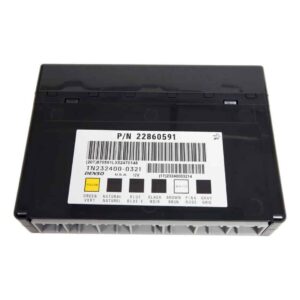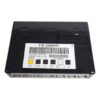Restore Full Functionality to Your GM Vehicle
Are you chasing down frustrating electrical gremlins in your 2009-2012 Chevrolet Traverse? Intermittent power windows, a security light that won’t turn off, or dashboard lights flickering for no reason are classic signs of a failing Body Control Module (BCM). As the central command center for your vehicle’s body electronics, a faulty BCM can cause a wide range of confusing and unpredictable issues. In my two decades of experience, I’ve seen these modules fail due to heat cycles and internal circuit board corrosion, leading to communication errors that can be a nightmare to diagnose.
This isn’t just a replacement part; it’s a complete, ready-to-install solution. We take the guesswork and high dealership costs out of the equation. Simply provide us with your vehicle’s VIN after purchase, and our technicians will program this module with the latest GM software specific to your Traverse. This ensures all your vehicle’s options and security systems communicate correctly right out of the box, making the repair process as smooth as possible for both seasoned mechanics and first-time DIYers.
Case Study: The Phantom Battery Drain
A customer brought in a 2011 Traverse with a classic complaint: a dead battery every morning. They had already replaced the battery and alternator, but the problem persisted. After connecting my diagnostic scanner, I noticed no active fault codes, but a parasitic draw test showed a significant power drain even with the key off. By pulling fuses one by one, we isolated the drain to a circuit controlled by the BCM. The module’s internal relays were sticking, keeping the interior lights and radio powered on at a low level long after the car was shut down. Replacing the faulty unit with a properly programmed 2009-2012 Traverse BCM solved the problem instantly, saving the customer from further diagnostic headaches and the cost of another new battery.
Common Signs of a Failing BCM
- ✔ Erratic or non-functional power windows, door locks, and interior/exterior lights.
- ✔ The security or anti-theft system light stays on, preventing the vehicle from starting.
- ✔ Dashboard warning lights appear randomly or stay illuminated.
- ✔ Communication error codes, such as U0100, U0140, or other “U-series” codes, stored in other modules.
- ✔ Wipers or radio turning on and off by themselves.
- ✔ A persistent battery drain that can’t be traced to other components.
A Straightforward Guide to BCM Installation
- ✔ Safety First: Always disconnect the negative terminal from your vehicle’s battery before starting any electrical work.
- ✔ Locate the BCM: On the 2009-2012 Traverse, the BCM is typically located on the left-hand (driver’s) side of the dashboard, often behind the lower dash panel near the steering column.
- ✔ Disconnect and Remove: Carefully unplug the electrical connectors from the old BCM. They have locking tabs that must be depressed to be released. Once disconnected, unbolt or unclip the module from its mounting bracket.
- ✔ Install the New Module: Mount your new, pre-programmed BCM in the same location and securely reconnect all electrical connectors. You should hear a ‘click’ as they lock into place.
- ✔ Reconnect Power: Re-attach the negative battery terminal and tighten it securely.
- ✔ Perform Final Checks: Start the vehicle and test all body functions—lights, locks, windows, radio, etc. Note that some post-install procedures may be required as detailed below.
Important Post-Installation Steps
While our VIN programming handles the majority of the setup, some GM vehicles require on-vehicle relearn procedures to sync all systems. These may include:
- Airbag System Sync: If the airbag warning light is on after installation, a ‘Setup SDM Primary Key in BCM’ procedure must be performed with a compatible high-level scan tool. This is a security measure to ensure the airbag system is correctly linked to the new BCM.
- Brake Pedal Position Relearn: On some models, a brake pedal position sensor recalibration might be needed to ensure accurate brake light operation and to prevent issues with the traction control system.
Will This Fit My Vehicle?
This BCM is a direct-fit replacement for the 2009-2012 Chevrolet Traverse and is also compatible with a wide range of other GM vehicles. Please verify your part number or match your vehicle from the list below. This module replaces the following part numbers: 10382479, 15093910, 15276271, 15299986, 15819552, 15828601, 15837419, 15872388, 15872421, 15880684, 15921352, 15921353, 15948438, 15948439, 20815898, 20839063, 20864767, 20864768, 20921435, 20921436, 20935349, 22860591, 25826124, 25826125, 25847588, 25847589, 25892622, 25910474, 25934762, 25934763, 95151084.
Frequently Asked Questions
Why do you need my VIN?
Your VIN (Vehicle Identification Number) allows us to program the BCM with the exact software and settings your Traverse was built with. This ensures all features, from your specific radio type to your security system, work correctly without a trip to the dealer.
Is this a difficult part to install myself?
For someone with basic mechanical skills, this is a very manageable job. The BCM is usually accessible behind a dash panel and involves unplugging a few connectors and removing some bolts. Our pre-programming service eliminates the most difficult step, which is the software setup.
Do I need to send my old BCM back?
No. This purchase requires no core charge. You can keep your original module, which can be helpful if you ever need to reference it.
What if my airbag light comes on after installation?
This is a normal security protocol on some GM vehicles. It means the new BCM needs to be electronically ‘introduced’ to the airbag’s computer (SDM). A repair shop with a professional-grade scan tool can perform the ‘Setup SDM Primary Key in BCM’ procedure in a few minutes to resolve this.
Will this fix my specific problem?
This BCM will correct issues directly caused by a faulty module. If you’re experiencing symptoms like erratic lights, lock/window failure, security system faults, or communication error codes, a failing BCM is the most likely culprit.


